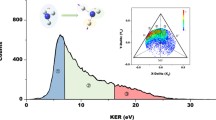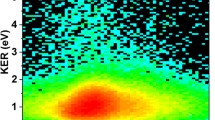Abstract
Various dissociation channels of OCSq+ (where q = 2 to 4), formed in the interaction of 5 MeV u-1 Si12+ ion beam with neutral OCS, have been studied using recoil–ion momentum spectroscopy. The concerted and/or sequential nature of dissociation is inferred from the shape and slope of the coincidence islands in the 2D coincidence map. It is observed that the C+ + S+ + O channel results from concerted as well as sequential decay of OCS2+. However the other channels originate purely from the concerted process in which the two terminal fragments (oxygen and sulphur) fly back to back and the central carbon fragment is left with negligible momentum. The kinetic energy release (KER) distributions for all the fragmentation channels arising from the dissociation of OCSq+ (where q = 2 to 4) have been measured and compared with the available data in the literature. It is observed that the KER values for complete Coulomb fragmentation channels are much smaller than those of incomplete Coulomb fragmentation cases and the KER increases with the increasing charge states of the parent molecular ions. From the momentum correlation map, we estimated the geometry of the precursor molecular ion undergoing three–body dissociation and inferred that bent dissociative states are involved in most of the fragmentation channels of OCSq+.
Similar content being viewed by others
References
G. Bilalbegović, Eur. Phys. J. D 49, 43 (2008)
A. Sugita, M. Mashino, M. Kawasaki, Y. Matsumi, R. Bersohn, G. Trott-Kriegeskorte, K. Gericke, J. Chem. Phys. 112, 7095 (2000)
D. Mathur, E. Krishnakumar, F.A. Rajgara, U.T. Rajeha, V. Krishnamurthi, J. Phys. B 25, 2997 (1992)
B. Siegmann, U. Werner, H.O. Lutz, R. Mann, J. Phys. B 35, 3755 (2002)
N. Neumann, D. Hant, L.Ph.H. Schmidt, J. Titze, T. Jahnke, A. Czasch, M.S. Schoffler, K. Kreidi, O. Jagutzki, H. Schmidt-Bocking, R. Dorner, Phys. Rev. Lett. 104, 103201 (2010)
P. Moretto-Capelle, D. Bordenave-Montesquieu, A. Bordenave-Montesquieu, J. Phys. B 33, L539 (2000)
P. Wang, C.R. Vidal, J. Chem. Phys. 118, 5383 (2003)
J.E. Hudson, C. Vallance, P.W. Harland, J. Phys. B 37, 445 (2004)
T. Masuoka, I. Koyano, N. Saito, J. Chem. Phys. 97, 2392 (1992)
M.L. Lipciuc, M.H.M. Janssen, J. Chem. Phys. 126, 194318 (2007)
W.A. Bryan, W.R. Newell, J.H. Sanderson, A.J. Langley, Phys. Rev. A 74, 053409 (2006)
J.H. Sanderson et al., Phys. Rev. A 65, 043403 (2002)
J. Laksman, D. Céolin, M. Gisselbrecht, S.L. Sorensen, J. Chem. Phys. 133, 144314 (2010)
M.R. Jana, B. Ray, P.N. Ghosh, C.P. Safvan, J. Phys. B 43, 215207 (2010)
B. Wales, T. Motojima, J. Matsumoto, Z. Long, W. Liu, H. Shiromaru, J. Sanderson, J. Phys. B 45, 045205 (2012)
D. Kanjilal, S. Chopra, M.M. Narayanan, I.S. Iyer, V. Jha, R. Joshi, S.K. Datta, Nucl. Instrum. Methods Phys. Res. A 328, 97 (1993)
R.K. Kushawaha, S. Sunil Kumar, M.R. Jana, I.A. Prajapati, C.P. Safvan, B. Bapat, J. Phys. B 43, 205204 (2010)
M.R. Jana, P.N. Ghosh, B. Bapat, R.K. Kushawaha, K. Saha, I.A. Prajapati, C.P. Safvan, Phys. Rev. A 84, 062715 (2011)
J.H.D. Eland, Mol. Phys. 61, 725 (1987)
V. Brites, J.H.D. Eland, M. Hochlaf, Chem. Phys. 346, 23 (2008)
Author information
Authors and Affiliations
Corresponding author
Rights and permissions
About this article
Cite this article
Jana, M.R., Ghosh, P.N., Ray, B. et al. Dissociation of OCS by high energy highly charged ion impact. Eur. Phys. J. D 68, 250 (2014). https://doi.org/10.1140/epjd/e2014-50367-0
Received:
Revised:
Published:
DOI: https://doi.org/10.1140/epjd/e2014-50367-0




